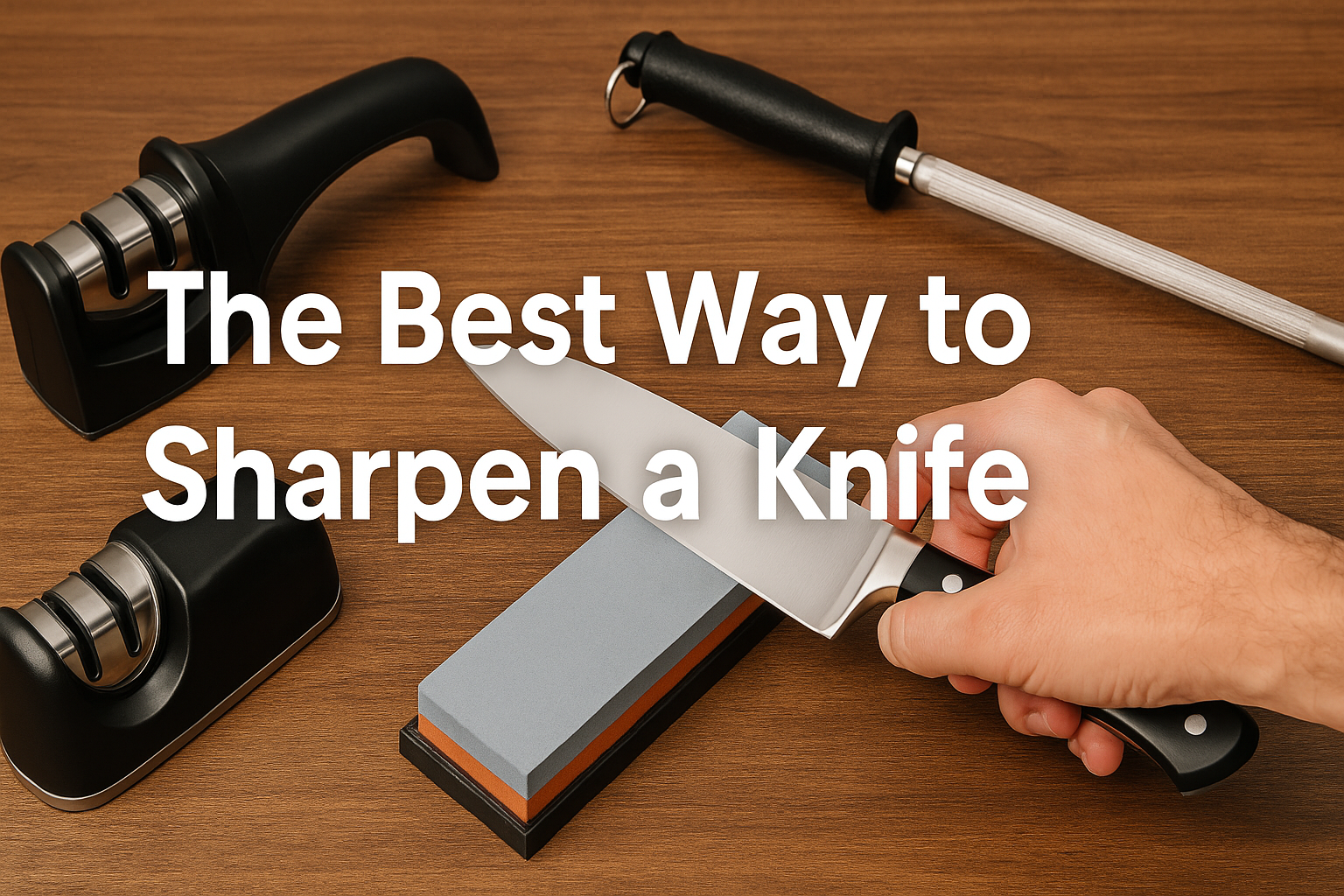A sharp knife is the heart of any kitchen, a trusted companion whether you’re slicing delicate herbs, dicing robust vegetables, or carving a roast. Over time, however, even the finest blades become dull. Knowing how to sharpen a knife properly isn’t just a skill—it’s an essential practice for ensuring precision, safety, and a long lifespan for your blades.
In this detailed guide, we’ll explore the best methods for sharpening knives, discuss the pros and cons of different tools, and provide expert tips to keep your knives razor-sharp. Let’s get started.
🔪 Why Knife Sharpening is Essential
A dull knife is more dangerous than a sharp one. When your blade isn’t cutting cleanly, you apply extra force, increasing the risk of slips and accidents. Plus, dull knives can damage food, crushing instead of slicing ingredients and affecting texture and presentation.
Properly sharpening your knives:
- Ensures cleaner, smoother cuts.
- Enhances cooking efficiency and precision.
- Reduces the risk of injury.
- Extends the lifespan of your knife.
🛠️ Sharpening vs. Honing: Know the Difference
Before we discuss the best sharpening method, it’s essential to understand the distinction between sharpening and honing.
- Sharpening involves grinding away metal to create a new edge on the blade. This restores a dull knife to sharpness.
- Honing realigns the edge of the blade by correcting minor bends and imperfections. It’s a maintenance step, not a substitute for sharpening.
Both are important, but sharpening should be done periodically, while honing can be done more frequently.

🏆 The Best Way to Sharpen a Knife: Whetstone (Sharpening Stone)
For those seeking precision, control, and the sharpest possible edge, a whetstone is the ultimate tool. Though it requires a bit of skill, the results are worth it.
🔹 Why Choose a Whetstone?
- Customizable sharpening angles.
- Works with all knife types, including Japanese and Western styles.
- Offers multiple grit levels for coarse grinding and fine polishing.
- Gentle on knives, preserving the blade’s integrity.
🔹 Step-by-Step Guide to Using a Whetstone
- Select the Stone: Use a two-sided stone with coarse (e.g., 1000 grit) and fine (e.g., 6000 grit) surfaces.
- Soak the Stone: If using a water stone, soak for 10-15 minutes. Oil stones require a few drops of honing oil.
- Position the Stone: Place it on a stable, non-slip surface.
- Angle the Knife: Hold the blade at a 15-20° angle. Japanese knives may require a slightly lower angle.
- Sharpen Side One: Slide the blade across the stone from heel to tip, applying light, consistent pressure. Repeat 10-15 times.
- Sharpen Side Two: Flip the knife and repeat.
- Switch to Fine Grit: Use the fine side to polish the edge.
- Test the Sharpness: Use the paper test or slice a tomato.
- Clean Up: Rinse the knife and stone, dry thoroughly.
🔹 Pro Tips:
- Maintain a consistent angle throughout.
- Start with slow, deliberate strokes to build muscle memory.
- Avoid excessive pressure to prevent gouging the blade.
- Finish with a honing rod to align the edge.
⚡ The Convenient Option: Electric Knife Sharpener
For those short on time or seeking convenience, an electric sharpener is a solid choice.
🔹 How It Works
Electric sharpeners use motorized abrasive wheels to sharpen knives at preset angles. They typically have coarse and fine slots for sharpening and polishing.
🔹 Pros:
- Quick and easy to use.
- Consistent results with minimal skill required.
- Great for home cooks and busy kitchens.
🔹 Cons:
- More expensive than manual tools.
- Removes more metal, potentially shortening knife lifespan.
- Less precise control over sharpening angle.
🔹 Tips:
- Use an electric sharpener sparingly for expensive knives.
- Read the manual to understand proper use and maintenance.
🧰 The Quick Fix: Manual Pull-Through Sharpener
Manual sharpeners, also known as pull-through sharpeners, are popular for their simplicity.
🔹 Pros:
- Easy to use with preset angles.
- Compact and portable.
- Inexpensive.
🔹 Cons:
- Less precise than whetstones or electric sharpeners.
- Can remove metal unevenly.
- Best for inexpensive or utility knives.
🔄 Daily Maintenance: Honing Rod
While not a sharpener per se, a honing rod is crucial for maintaining a knife’s sharpness between sharpenings.
🔹 How to Use a Honing Rod:
- Hold the rod vertically on a non-slip surface.
- Position the knife at a 15-20° angle.
- Sweep the blade down and across the rod, alternating sides.
- Repeat 5-10 times per side.
📅 How Often Should You Sharpen Your Knife?
- Home Cooks: Sharpen every 3-6 months, hone frequently.
- Professional Chefs: Sharpen every few weeks, hone before each use.
- Signs It’s Time to Sharpen: Difficulty slicing tomatoes, dull feeling, or tearing food.
🔐 Knife Care After Sharpening
- Wash and dry your knife immediately.
- Store knives in a block, magnetic strip, or protective sleeve.
- Use a wooden or plastic cutting board.
- Avoid dishwasher cleaning to preserve the edge.
💡 Final Verdict: What’s the Best Way to Sharpen a Knife?
🔹 For precision and long-term care, whetstones are the gold standard.
🔹 For convenience and ease, an electric sharpener is a solid backup.
🔹 For daily maintenance, a honing rod keeps the edge aligned.
A combination of these methods ensures your knives stay sharp, safe, and effective for years.
Frequently Asked Questions (FAQ) About Knife Sharpening
🔪 Q1: How can I tell if my knife is dull and needs sharpening?
A simple test is to slice through a sheet of paper or a ripe tomato. A sharp knife should glide through with little resistance. If it tears or crushes the item, it’s time to sharpen.
🕒 Q2: How often should I sharpen my knife?
For home cooks, sharpening every 3-6 months is typical. For professional chefs or those who cook frequently, every few weeks might be necessary. Use a honing rod for regular maintenance between sharpenings.
⚠️ Q3: Can I use an electric sharpener for all types of knives?
Electric sharpeners are convenient but may not be suitable for delicate or high-end knives, such as Japanese knives or those with thin blades. Whetstones are preferred for precision and minimal material removal.
🧼 Q4: Should I wash my knife before or after sharpening?
Always clean your knife both before and after sharpening to remove food particles or metal filings. Wash with mild soap and warm water, then dry thoroughly to prevent rust.
🔄 Q5: What angle should I use when sharpening my knife?
Most Western-style knives are sharpened at a 20° angle, while Japanese knives often require a 15° angle. Maintaining a consistent angle is more important than the exact number.
🏠 Q6: What’s the difference between a sharpening steel and a honing rod?
Both terms are often used interchangeably, but technically, a honing rod realigns the knife edge, while a sharpening steel (if made with abrasives) can remove metal. Most household “sharpening steels” are actually honing rods.
💧 Q7: Should I use a dry or wet whetstone?
Water stones should be soaked in water for 10-15 minutes before use, while oil stones require a light coating of honing oil. Never use water on an oil stone and vice versa.
🔥 Q8: Can I oversharpen my knife?
Yes. Sharpening too often or using too much pressure can wear down the blade and shorten its lifespan. Only sharpen when you notice a drop in performance.
🛡️ Q9: How do I store my knife to keep it sharp?
Store knives in a knife block, on a magnetic strip, or in a protective sheath. Avoid tossing them in a drawer, which can dull the edge.
🧑🍳 Q10: Should I invest in a professional sharpening service?
For high-end or specialty knives, periodic professional sharpening can extend their life. However, learning to use a whetstone at home gives you control and cost savings.

